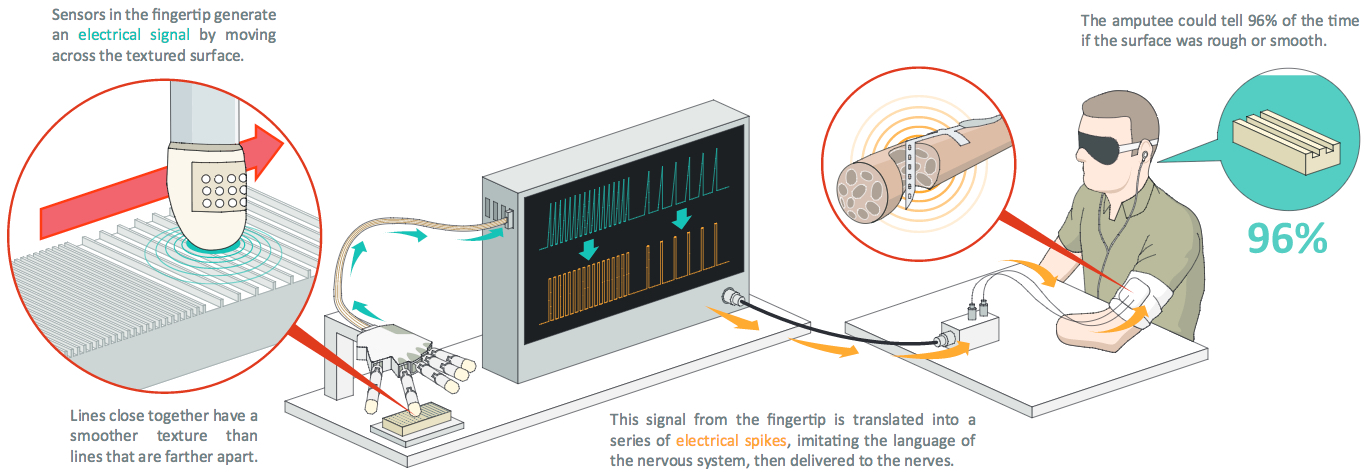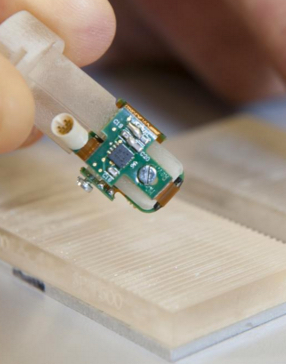Amputee feels texture with a ‘bionic’ fingertip
March 10, 2016

An amputee feels texture in real time: Signals from sensors in an artificial fingertip are converted to neural-like spikes and delivered to nerves in the upper arm. (credit: Ecole polytechnique fédérale de Lausanne)
Amputee Dennis Aabo Sørensen is the first person in the world to recognize texture (smoothness vs. roughness) using an artificial “bionic” fingertip surgically connected to nerves in his upper arm. The experimental system was developed by EPFL (Ecole polytechnique fédérale de Lausanne) and SSSA (Scuola Superiore Sant’Anna).
“The stimulation felt almost like what I would feel with my hand,” says Sørensen. “I felt the texture sensations at the tip of the index finger of my phantom hand.”

Bionic fingertip electronics and plastic gratings with rough and smooth textures (credit: Hillary Sanctuary/EPFL)
As a test, a machine controlled the movement of the fingertip over different pieces of plastic engraved with different patterns, smooth or rough, as sensors generated an electrical signal. This signal was translated into a series of electrical spikes, imitating the language of the nervous system, then delivered to the nerves.
But how does this sensation relate to the feeling of touch from a real finger? The scientists tested that by comparing brain-wave activity of amputees to non-amputees. The brain scans were similar.
“This study provides additional evidence that research in neuroprosthetics can contribute to [understanding] neuronal mechanisms of the human sense of touch,” says Calogero Oddo of the BioRobotics Institute of SSSA. “It will also be translated to other applications, such as artificial touch in robotics for surgery, rescue, and manufacturing.”
The research is described in an open-access paper on the journal e-Life. It was carried out in collaboration with Università di Pisa, IRCCS San Raffaele Pisana, Università Cattolica del Sacro Cuore, and Università Campus Biomedico.
The work was partly supported by EU Grants TIME, NEBIAS and NANOBIOTOUCH; by the ENABLE project, funded by the Wyss Center for Bio and Neuroengineering; by the Swiss National Competence Center in Research in Robotics; and by Italian grants NEMESIS (funded by the Italian Ministry of Health), PRIN/HandBot (funded by the Italian Ministry of Research), and PPR2 (funded by the National Institute for Insurance against Industrial Injuries).
Abstract of Intraneural stimulation elicits discrimination of textural features by artificial fingertip in intact and amputee humans
Restoration of touch after hand amputation is a desirable feature of ideal prostheses. Here, we show that texture discrimination can be artificially provided in human subjects by implementing a neuromorphic real-time mechano-neuro-transduction (MNT), which emulates to some extent the firing dynamics of SA1 cutaneous afferents. The MNT process was used to modulate the temporal pattern of electrical spikes delivered to the human median nerve via percutaneous microstimulation in four intact subjects and via implanted intrafascicular stimulation in one transradial amputee. Both approaches allowed the subjects to reliably discriminate spatial coarseness of surfaces as confirmed also by a hybrid neural model of the median nerve. Moreover, MNT-evoked EEG activity showed physiologically plausible responses that were superimposable in time and topography to the ones elicited by a natural mechanical tactile stimulation. These findings can open up novel opportunities for sensory restoration in the next generation of neuro-prosthetic hands.
The technology to deliver this sophisticated tactile information was developed by Silvestro Micera and his team at together with Calogero Oddo and his team at SSSA.